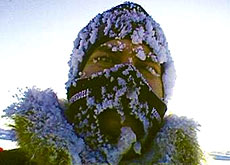Polar study launched amid global warming

Swiss glaciologists are preparing to monitor the ice in Greenland as ceremonies got underway on Thursday to mark the start of International Polar Year (IPY).
During the year, backed by the United Nations, about 50,000 people will be involved in more than 200 projects.
The 228 projects include a study into marine life in the Antarctic, mapping how winds carry pollutants to the Arctic, and examining the health of people, polar bears and penguins.
Martin Lüthi, a glaciologist at the Federal Institute of Technology in Zurich, will travel to the Jakobshavn glacier in western Greenland in mid-May for a month to conduct research.
“The biggest changes to the world’s climate will come from the polar regions in the next couple of decades,” Lüthi told swissinfo. “They are the cradle of all storms. If there are big changes there, it will affect the weather throughout the world.”
Lüthi and his colleagues will use GPS (Global Positioning System) to determine the exact movement of the glacier, which is moving outwards towards the ocean and dumping ice into the sea. The rate of movement has increased from one metre an hour to two metres an hour in the past five years.
“Weird things”
“We’re trying to work out what caused this acceleration in movement, what effects it will have and how it will evolve,” Lüthi said. “The glacier is doing very weird things: it accelerates for a bit and then stops. If you can understand this jerky movement, you can make better predictions of what it will do.”
Scientists believe this movement is caused by warmer currents melting the ice pack in front of the glacier. Arctic temperatures are rising fast because water or ground, once exposed, soaks up far more heat from the sun than ice or snow. Antarctica is staying cooler, with its far bigger volume of ice acting as a deep freeze.
“The biggest impact if this goes on at this rate is that we will see more ice flowing into the sea which will affect ocean levels. Greenland contributes five to ten per cent of the rising ocean levels,” Lüthi said.
A melt of ice sheets on Greenland or Antarctica in coming centuries would raise world sea levels, threatening cities from Tokyo to New York and low-lying coral atolls in the Pacific.
Global efforts
The project, funded by the Swiss National Science Foundation and its counterpart in the United States and coordinated by the universities of Fairbanks, Alaska, and New Hampshire, began a year ago but has come under the umbrella of IPY this year. Switzerland is not, however, officially taking part in the IPY.
David Carlson, director of the IPY Programme Office, said the icy ends of the earth had been overlooked for too long. “This part of the planet has its problems and it needs to get a higher level of attention.”
Lüthi added: “IPY is very important because it concentrates global efforts and increases funding to enable individual research teams to tackle large fundamental projects that they could not normally dream about.”
swissinfo
The three fastest-warming regions on the planet in the past two decades have been Alaska, Siberia and parts of the Antarctic Peninsula.
Melting sea ice in the Arctic due to rising temperatures is causing declines in ice algae crucial to the entire Arctic food chain, from fish to seals and polar bears.
Scientists believe global warming is caused by the release of greenhouse gases into the atmosphere by industrialised nations.
There have been a number of major international polar initiatives since the first International Polar Year in 1882-83.
The last such initiative was the International Geophysical Year in 1957-58, involving 80,000 scientists from 67 countries, including Switzerland.
An International Polar Year in 2007-2008 aims to engage young scientists and to make the public aware of the polar regions’ importance.
In a UN report in January the world’s top climate scientists said that “average Arctic temperatures increased at almost twice the global average rate in the past 100 years”.
They projected that sea levels could rise by 18-59cm by 2100, by which time Arctic sea ice may disappear in summers.
Nordic nations, with Arctic territories, fear businesses including tourism are vulnerable to warming.

In compliance with the JTI standards
More: SWI swissinfo.ch certified by the Journalism Trust Initiative











You can find an overview of ongoing debates with our journalists here . Please join us!
If you want to start a conversation about a topic raised in this article or want to report factual errors, email us at english@swissinfo.ch.